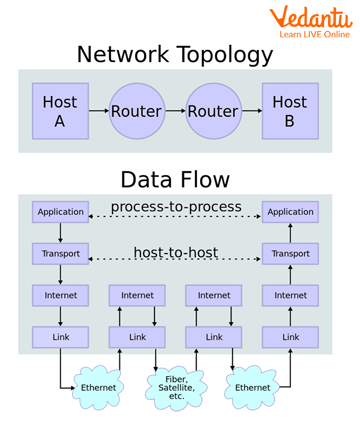




Introduction
A network protocol is a set of established rules that dictate how to format, transmit and receive data so that computer network devices from servers and routers to endpoints can communicate, regardless of the differences in their underlying infrastructures, designs or standards. To send and receive information, devices on both sides of a communication exchange must accept and follow protocol conventions. In networking, support for protocols can be built into hardware, software or both.
Computing protocols is necessary as devices would not know how to engage with each other. Virtually all network end users rely on network protocols for connectivity. Network protocols make it possible for devices to interact with each other because of predetermined rules built into devices’ software and hardware.

Network Topology
Types of Network Protocols
There are three types of protocols in networking and communication like management, Transfer Protocol (SMTP) and security.
In these three broad categories, there are thousands of protocols that have a defined variety of tasks, including automation, correction, semantics, file transfer etc.
How Network Protocols Work?
Network protocols take large-scale processes and break them down into small, specific tasks or functions.
This occurs at every level of the network, and each function must cooperate at each level to complete the larger task at hand.
A set of cooperating network protocols is called a protocol suite.The term protocol suite refers to a set of smaller network protocols working in conjunction with each other.
Network protocols are typically created according to industry standards by various networking or information technology organisations.
Network protocol models work in similar ways, but each protocol is unique in its own way according to the organisation that created it.
The Transmission Control Protocol/Internet Protocol (TCP/IP) suite, which is typically used in client-server models, includes numerous protocols across layers such as the data, network, transport and application layers working together to enable internet connectivity. These include the following:
User Datagram Protocol(UDP): It acts as an alternative communication protocol to TCP and is used to establish loss tolerating and low latency connections between applications and the internet.
TCP:It uses a set of rules to exchange messages with other internet points at the information packet level.
IP: It uses a set of rules to send and receive messages at the level of IP addresses.

Network Protocol
How are Network Protocols Used?
Some specific examples of network protocols and their uses include the following:
Post office protocol: It is a standard protocol which is used to receive emails.
FTP: It is used to transfer files from one to another.
Telnet: It is a tool which is used to connect one system to another through logging in.
SMTP: It is used to send and distribute outgoing mails.
What Protocols do Routers Use?
A Routable protocol is a network protocol which can carry data from one network and can pass through the router to reach another network and be delivered to a computer in that remote network.These protocols are not used for transferring user data. Important network routing protocols include:
Router Information Protocol: The RIP is an older routing protocol that identifies distances between routers. RIP is an application layer protocol.
BGP: The Border Gateway Protocol is an application layer protocol networks use to broadcast which IP addresses they control. This information allows routers to decide which networks data packets should pass through on the way to their destinations.
EIGRP: The Enhanced Interior Gateway Routing Protocol (EIGRP) identifies distances between routers. EIGRP automatically updates each router's record of the best routes and broadcasts those updates to other routers within the network.
OSPF: The Open Shortest Path First protocol calculates the most efficient network routes based on a variety of factors, including distance and bandwidth.
Summary
Network Protocols are a set of rules governing exchange of information in an easy, reliable and secure way. A Routable protocol is a network protocol which can carry data from one network and can pass through the router to reach another network and be delivered to a computer in that remote network. Without computing protocols, computers and other devices would not know how to engage with each other. Every packet transmitted and received over a network contains binary data.
Learning by Doing
1. Which from the following is not a network protocol?
TCP
User Datagram Protocol
IP
ZPU
2. Which of the following is not a routing networking protocol?
OSPF
RIP
BGMI
EIGRP
Sample Solved Questions
1. What are the disadvantages of network protocol?
Ans: Some disadvantages are:-
Network protocols are not designed for security.
Their lack of protection can sometimes enable malicious attacks, such as eavesdropping and cache poisoning, to affect the system.
The most common attack on network protocols is the advertisement of false routes, causing traffic to go through compromised hosts instead of the appropriate ones.
2. What is a TCP IP protocol?
Ans: TCP stands for Transmission Control Protocol, a communications standard that enables application programs and computing devices to exchange messages over a network. It is designed to send packets across the internet and ensure the successful delivery of data and messages over networks.
FAQs on Network Protocol
1. What is the most widely used protocol?
TCP IP is the most widely used protocol.
2. What is LAN MAN and WAN network?
LAN stands for Local Area Network. MAN stands for Metropolitan Area Network. WAN stands for Wide Area Network.
3. What is the UDP protocol?
User Datagram Protocol (UDP) refers to a protocol used for communication throughout the internet. It is specifically chosen for time-sensitive applications like gaming, playing videos, or Domain Name System (DNS) lookups.





















